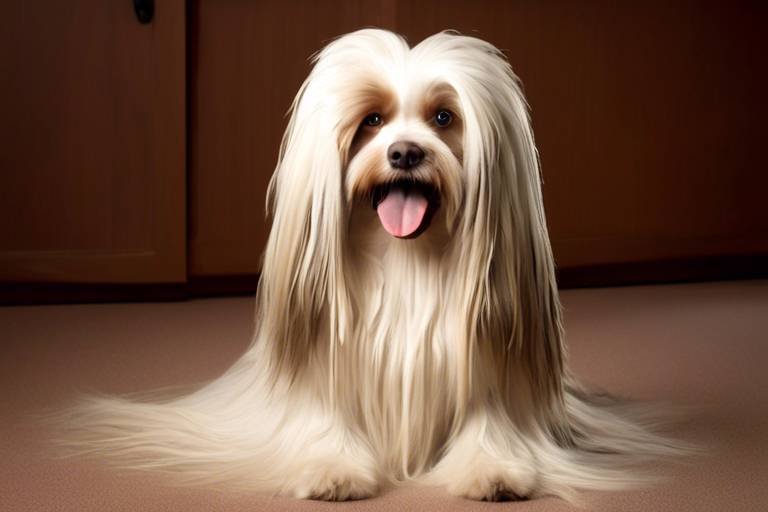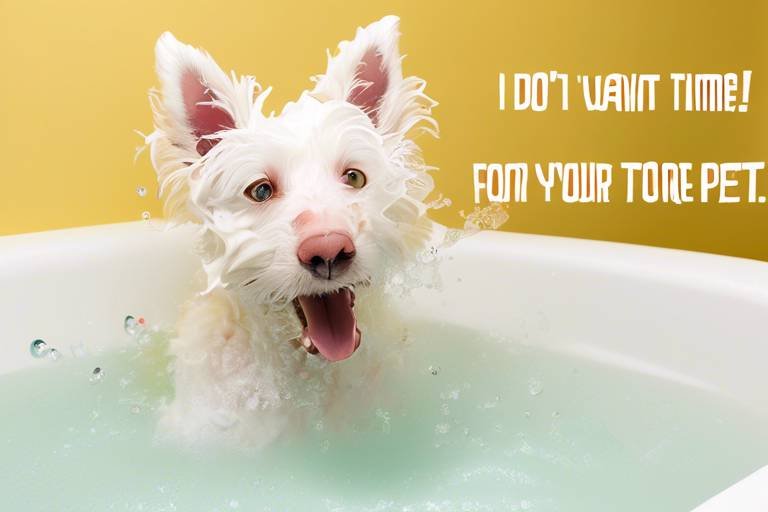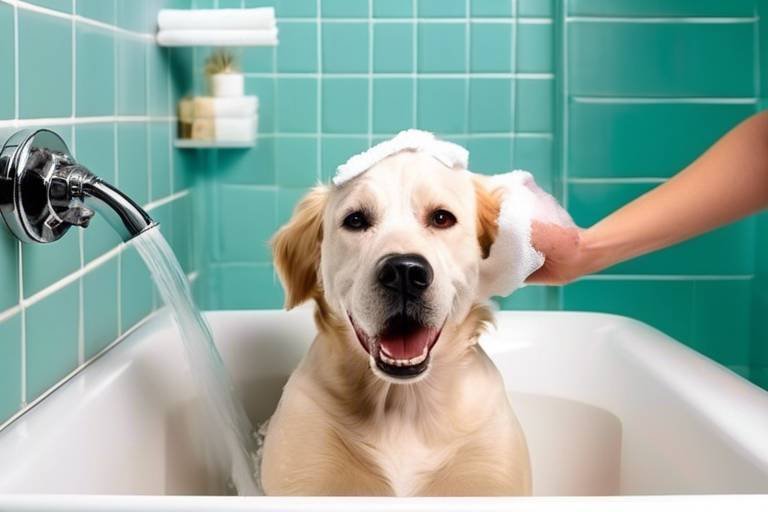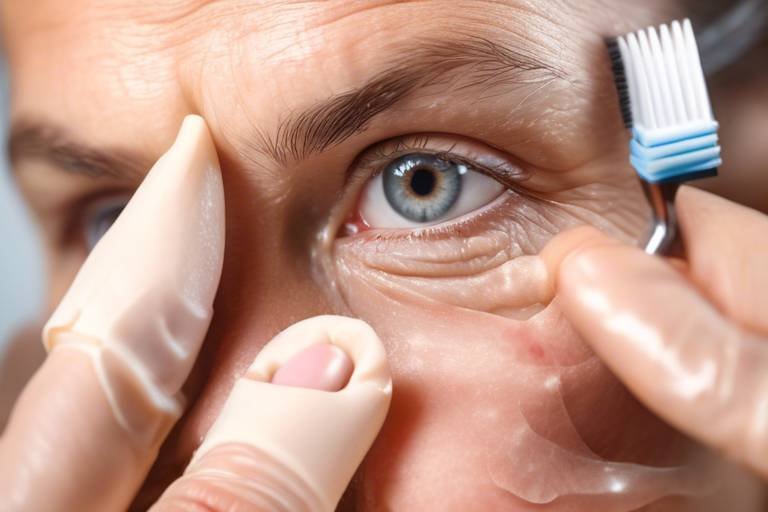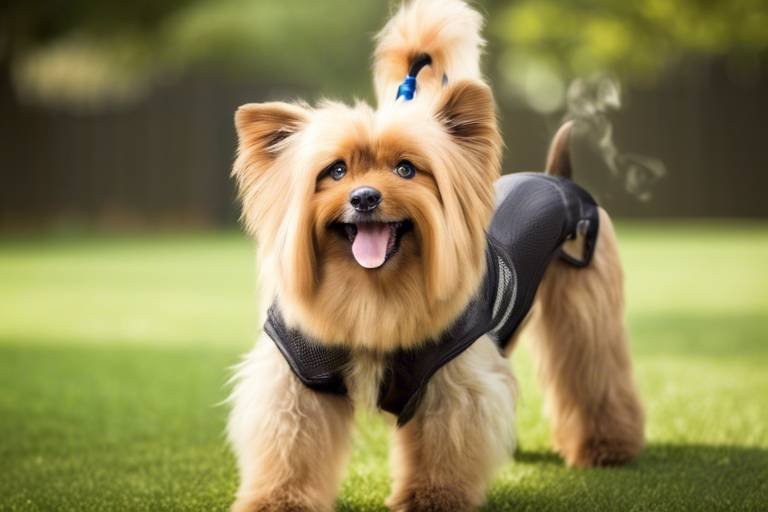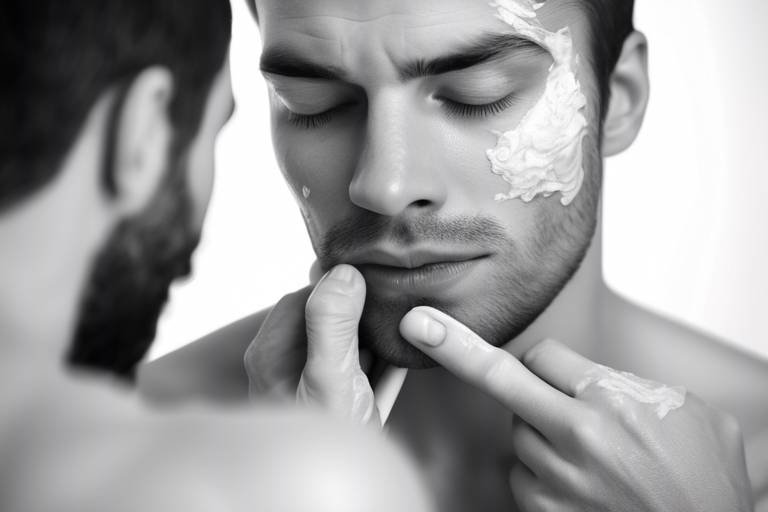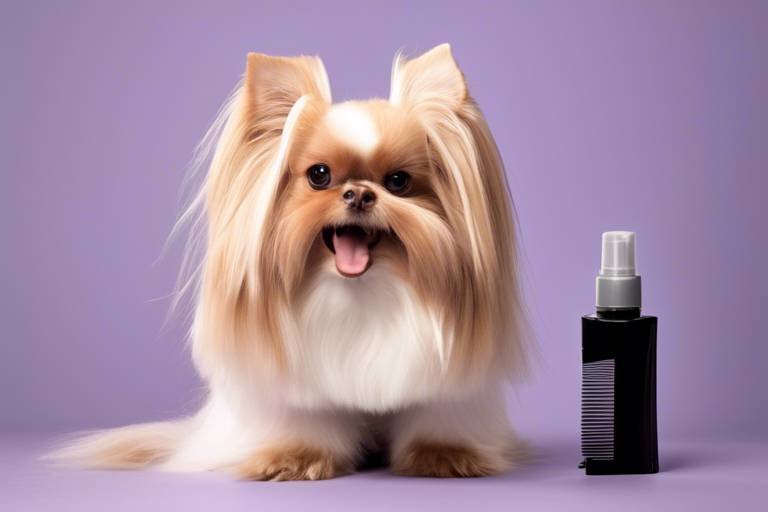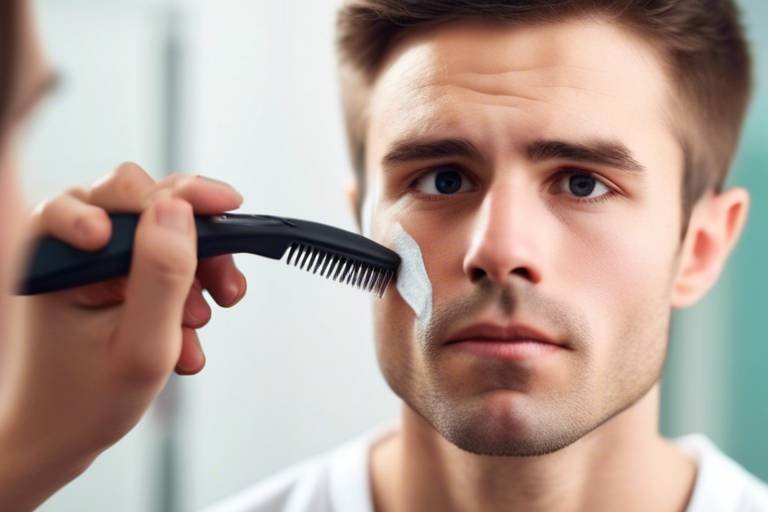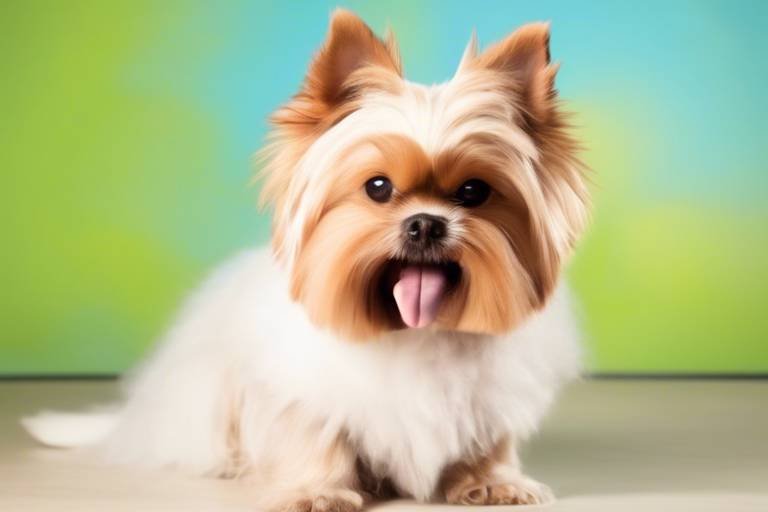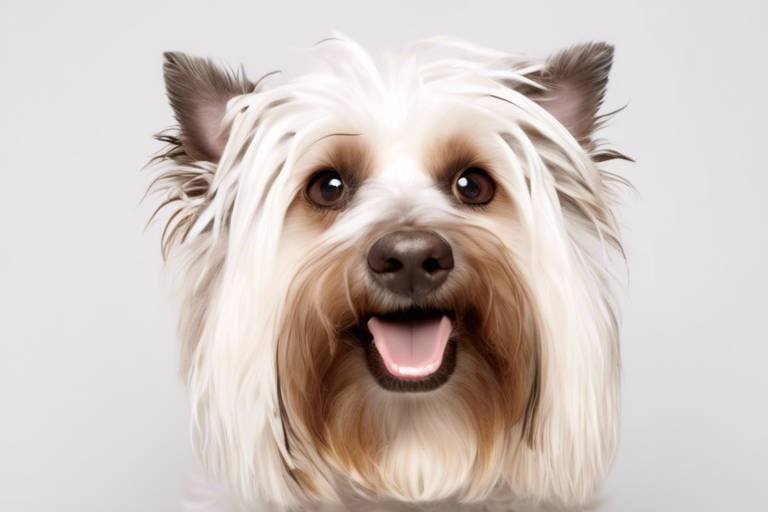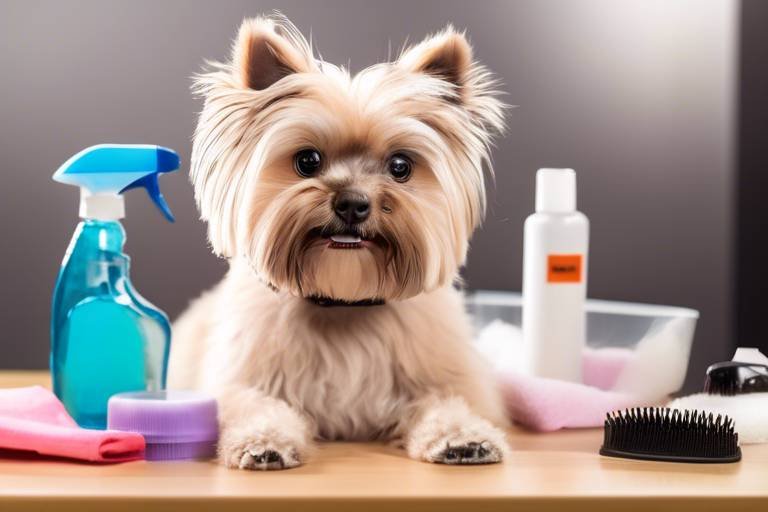How to Deal with Matting in Long-Haired Pets
Long-haired pets are undeniably beautiful, but they come with their own set of challenges, one of the biggest being matting. As a pet owner, you might find yourself puzzled when you discover those painful tangles in your furry friend's coat. Matting can be more than just an aesthetic issue; it can lead to serious discomfort and health problems for your pet. In this article, we’ll dive deep into effective strategies for preventing and managing matting, ensuring your pet remains comfortable, healthy, and as stunning as ever.
Matting occurs when the fur becomes tangled and knotted, creating clumps that can pull on the skin and lead to irritation. This is especially common in long-haired breeds like Persian cats or Yorkshire Terriers. But why does matting happen in the first place? There are several factors that contribute to this frustrating issue:
- Insufficient grooming: Regular grooming is essential to keep your pet's coat healthy.
- Environmental factors: Dirt, debris, and moisture can all contribute to tangles.
- Health issues: Skin conditions or obesity can prevent your pet from grooming themselves properly.
Understanding these causes is the first step in taking preventive measures. By staying proactive, you can maintain your pet's coat effectively and keep them comfortable.
Regular grooming is your best defense against matting. It’s not just about keeping your pet looking fabulous; it’s about maintaining their overall health. So, what are some effective grooming techniques to consider? Here are a few:
Selecting the appropriate grooming tools is crucial for effective grooming. Not all brushes are created equal, and using the wrong one can exacerbate matting rather than alleviate it. Here’s a quick rundown of the essential grooming tools you might need:
| Tool Type | Purpose |
|---|---|
| Slicker Brush | Removes loose fur and detangles knots. |
| Pin Brush | Helps smooth the coat and remove debris. |
| Wide-Tooth Comb | Great for gently detangling without pulling on the fur. |
Using the right tools can make a world of difference in your grooming routine and help reduce matting significantly.
Now that you have your tools, how often should you groom your long-haired pet? The frequency largely depends on your pet's coat type and lifestyle. For instance, pets that spend a lot of time outdoors may require more frequent grooming compared to those who are mostly indoors. As a general guideline:
- Daily grooming for pets with very long hair.
- Every other day for moderately long hair.
- Weekly for shorter long-haired breeds.
Establishing a consistent grooming schedule will not only help keep your pet’s coat healthy but also strengthen the bond between you and your furry friend.
Recognizing mats early can prevent further complications. If you notice any areas of your pet's coat that feel rough or look uneven, it’s time to take action. Here’s how to safely remove mats:
- Gently hold the base of the mat to avoid pulling on the skin.
- Use a slicker brush to carefully work through the mat from the edges inward.
- If necessary, use scissors to cut the mat out, being extremely cautious not to cut your pet’s skin.
Always approach mat removal with patience and care to ensure your pet remains comfortable throughout the process.
Sometimes, despite your best efforts, you may need to seek professional help. Professional groomers have the training and tools to handle mats that are too stubborn or painful to remove at home. But when should you consider taking your pet to a groomer?
- If mats are extensive and causing discomfort.
- If your pet has developed skin issues due to matting.
- If you’re unsure about how to safely remove mats.
Finding a qualified groomer is crucial. Look for someone who specializes in long-haired breeds and has good reviews from other pet owners.
Grooming costs can vary significantly depending on your location and the services provided. On average, you can expect to pay between $30 to $90 for a grooming session, which can include washing, cutting, and styling. It’s essential to budget for these expenses, as regular grooming can save you from costly vet bills down the line.
Neglecting matting can lead to various health issues, including skin infections, discomfort, and even behavioral problems. Mats can trap moisture and dirt against the skin, creating an ideal environment for bacteria and parasites.
Be on the lookout for signs of skin problems related to matting, such as:
- Redness or irritation of the skin.
- Unusual scratching or biting at the coat.
- Foul odors emanating from the coat.
If you notice any of these signs, it’s crucial to consult a veterinarian for proper diagnosis and treatment.
Maintaining your pet's overall health can significantly help prevent matting. Ensure your pet has a balanced diet, stays hydrated, and receives regular veterinary check-ups. A healthy pet is less likely to develop mats, as they will be more active and able to groom themselves effectively.
Q: How can I prevent matting in my long-haired pet?
A: Regular grooming, using the right tools, and establishing a grooming schedule are key to preventing matting.
Q: What should I do if my pet has severe mats?
A: If mats are extensive, consider seeking professional grooming services to avoid causing pain to your pet.
Q: How often should I groom my long-haired pet?
A: The frequency depends on your pet's coat type, but generally, daily to weekly grooming is recommended.

Understanding Matting
Matting is a common issue faced by owners of long-haired pets, and it can be a real headache if not managed properly. Imagine your pet's beautiful coat, flowing and shiny, suddenly transforming into a tangled mess of knots. This not only looks unappealing but can also lead to serious discomfort for your furry friend. Matting occurs when fur tangles and knots together, creating clumps that can pull on the skin, making it painful for your pet. But what causes this to happen? There are several factors at play, including:
- Infrequent Grooming: Long-haired pets require regular grooming to remove loose hair and prevent tangles.
- Environmental Factors: Dirt, debris, and moisture can contribute to matting, especially if your pet enjoys outdoor adventures.
- Health Issues: Conditions like obesity or arthritis can make it difficult for pets to groom themselves properly, leading to matting.
Understanding these causes is the first step in taking preventive measures. The discomfort caused by matting can lead to skin irritations and infections, as the tight knots can trap moisture and bacteria against the skin. Not only does this affect your pet's comfort, but it can also lead to more severe health issues if left unchecked. Regular grooming and attention to your pet's coat can significantly reduce the risk of matting. It's essential to establish a routine that suits your pet's specific needs based on their coat type and lifestyle.
Moreover, recognizing the early signs of matting is crucial. If you notice small tangles forming, it’s best to address them immediately before they turn into larger, more painful mats. Don’t wait until your pet is visibly uncomfortable or in distress. Remember, a well-groomed pet is a happy pet!
In summary, understanding matting and its causes allows pet owners to take proactive steps to ensure their long-haired companions remain comfortable and healthy. By incorporating regular grooming into your pet care routine and being vigilant about any signs of matting, you can help maintain your pet's beautiful coat and overall well-being.

Preventive Grooming Techniques
When it comes to long-haired pets, preventive grooming is not just a luxury; it's a necessity. Regular grooming sessions can mean the difference between a healthy, happy pet and one that suffers from painful mats and tangles. Think of grooming as a bonding experience between you and your furry friend, where you both can enjoy some quality time together while keeping their coat in tip-top shape. But how do you effectively prevent matting? Let’s dive into some essential techniques that will keep your pet looking fabulous!
First and foremost, establishing a routine is key. Depending on your pet’s coat type, you might need to groom them daily, weekly, or bi-weekly. For instance, if your pet has a thick, fluffy coat, daily brushing is ideal. On the other hand, a pet with a finer coat may only require grooming once a week. Keeping a consistent schedule not only helps maintain their coat but also allows you to check for any skin issues or irritations early on.
Next, let’s talk about the tools you’ll need. The right grooming tools can make a world of difference. Investing in quality brushes and combs designed specifically for your pet's coat type can significantly reduce matting. For example, slicker brushes are excellent for removing loose hair and tangles, while pin brushes are fantastic for fluffing up the coat and preventing flatness. A good comb can help you get into those tricky spots where mats like to hide. Remember, using the wrong tools can lead to frustration for both you and your pet, so choose wisely!
Moreover, technique matters. When brushing your pet, always start from the roots and work your way out to the tips. This method helps to gently detangle any knots without pulling on the skin. If you come across a mat, resist the urge to yank it out. Instead, hold the base of the mat close to the skin to minimize discomfort and gently work through it with your fingers or a comb. This not only ensures a more pleasant experience for your pet but also helps to keep their skin intact.
Finally, don't forget to incorporate positive reinforcement into your grooming routine. Treats, praise, and lots of belly rubs can turn grooming time into a fun, enjoyable experience. This approach not only helps your pet associate grooming with positive feelings but also makes the process smoother for you as well.
In summary, preventive grooming techniques are essential for maintaining the health and beauty of your long-haired pets. Establish a routine, invest in the right tools, use proper techniques, and remember to keep things positive. By doing so, you’ll not only prevent matting but also strengthen the bond with your furry companion.
- How often should I groom my long-haired pet? It depends on the coat type, but daily to weekly grooming is generally recommended.
- What tools do I need for grooming? A slicker brush, pin brush, and a comb are essential for long-haired pets.
- Can I remove mats myself? Yes, but be gentle and consider consulting a professional if the mats are severe.
- What are signs that my pet needs grooming? Look for tangles, mats, and excessive shedding as indicators that it’s time for a grooming session.
Choosing the Right Tools
When it comes to grooming long-haired pets, can make all the difference in maintaining a healthy and beautiful coat. Imagine trying to untangle a stubborn knot in your hair with a fork—frustrating, right? The same goes for your furry friend. Using the appropriate grooming tools not only makes the process easier but also ensures your pet's comfort during grooming sessions.
First, let's talk about brushes. There are several types available, each designed for specific purposes. For instance, a slicker brush is great for removing loose fur and detangling knots, while a pin brush can help smooth the coat and distribute natural oils. It's like having a toolbox for your pet's grooming needs! Here’s a quick overview of some essential grooming tools:
| Tool Type | Best For |
|---|---|
| Slicker Brush | Removing tangles and mats |
| Pin Brush | Smoothing and fluffing the coat |
| Wide-Tooth Comb | Detangling without pulling |
| De-shedding Tool | Reducing shedding and loose fur |
Next, consider the size and shape of the tools. A brush that feels comfortable in your hand will make the grooming process less of a chore and more of a bonding experience with your pet. Additionally, for pets with sensitive skin, look for brushes with rounded tips to prevent irritation. Just like you wouldn’t wear shoes that pinch your feet, your pet deserves tools that feel good against their skin!
Another important aspect is the grooming frequency. If your pet has a particularly thick or long coat, investing in a quality grooming tool is essential. You might find yourself reaching for that slicker brush more often than you think, especially during shedding seasons. Regular grooming not only helps prevent matting but also keeps your pet looking fabulous!
In conclusion, choosing the right grooming tools involves understanding your pet's unique coat type and needs. Whether it's a slicker brush for detangling or a pin brush for smoothing, having the right tools can turn grooming from a dreaded task into a delightful experience for both you and your pet. Remember, a well-groomed pet is a happy pet!
Brush Types and Their Uses
When it comes to grooming your long-haired pet, the right brush can make all the difference. Each type of brush serves a specific purpose, and understanding these can help you maintain your pet's coat in the best possible condition. For instance, using a slicker brush is ideal for removing loose fur and detangling knots. The fine, short wires on a slicker brush can penetrate deep into your pet's coat, effectively catching and pulling out mats without causing discomfort.
On the other hand, a pin brush is particularly useful for pets with longer, flowing coats. Its longer, flexible pins help to separate fur strands, making it easier to manage tangles without breaking the hair. This brush is perfect for daily grooming sessions, as it can keep your pet's coat looking sleek and shiny while also helping to distribute natural oils throughout the fur.
Additionally, a wide-toothed comb can be a game changer for those stubborn mats that just won’t budge. It’s essential to start at the tips of the fur and work your way up to the roots gently. This technique helps to avoid pulling on the skin, which can be uncomfortable for your furry friend. If you encounter a particularly tough knot, don’t panic! You can use your fingers to gently loosen the mat before using the comb.
Here’s a quick reference table summarizing the different types of brushes and their uses:
| Brush Type | Best For | Usage Tips |
|---|---|---|
| Slicker Brush | Removing loose fur and detangling | Use in short strokes, starting from the base of the coat. |
| Pin Brush | Long, flowing coats | Brush gently to avoid breakage; ideal for daily use. |
| Wide-Toothed Comb | Detangling stubborn mats | Start at the tips and work your way up to prevent discomfort. |
Each grooming tool plays a vital role in your pet's grooming routine, and knowing when and how to use them can save you time and effort. Regular brushing not only prevents matting but also helps promote a healthy coat and skin. So, next time you grab your grooming tools, remember that the right brush can be your best friend in the fight against matting!
Frequency of Grooming
When it comes to maintaining the gorgeous coats of long-haired pets, is key. But how often should you pick up that brush? The answer can vary widely based on several factors, including your pet’s breed, coat type, and lifestyle. For instance, a fluffy Persian cat might need daily grooming to prevent those dreaded mats, while a long-haired Dachshund might only require a thorough brushing two to three times a week. It’s like tending to a garden—some plants need daily care, while others thrive on less frequent attention.
To make it easier, here’s a simple breakdown:
| Pet Type | Recommended Grooming Frequency |
|---|---|
| Persian Cats | Daily |
| Long-Haired Dachshunds | 2-3 times a week |
| Golden Retrievers | Weekly |
| Shih Tzus | Every other day |
| Yorkshire Terriers | Every day |
Establishing a grooming routine not only helps keep your pet's coat looking fabulous, but it also allows you to check for any skin issues or parasites that may be lurking beneath the fur. Think of it as a bonding time—your pet will learn to associate grooming with affection and care, making the process smoother and more enjoyable for both of you.
Moreover, consider your pet's activity level. Pets that are more active or spend time outdoors may require more frequent grooming to remove dirt, debris, and tangles that come from their adventures. On the other hand, if your furry friend is more of a couch potato, you might find that a less frequent schedule suffices. Just remember, consistency is crucial! If you establish a routine early on, your pet will adapt to the process, making it a breeze.
In conclusion, while the frequency of grooming can vary, the most important aspect is to stay consistent. Regular grooming not only helps in managing matting but also contributes to your pet's overall health and happiness. So, grab that brush and make it a part of your daily or weekly ritual—your long-haired pet will thank you for it!
- How often should I groom my long-haired pet? It depends on the breed and lifestyle, but generally, daily to weekly grooming is recommended.
- What tools do I need for grooming? A slicker brush, comb, and possibly a de-shedding tool are great choices for long-haired pets.
- Can I groom my pet myself? Absolutely! With the right tools and techniques, you can maintain your pet's coat at home.
- When should I seek professional grooming help? If mats are severe or if your pet is anxious during grooming, a professional groomer can help.
Identifying and Addressing Existing Mats
When it comes to long-haired pets, the presence of mats can be a significant concern. These tangled clumps of fur not only look unsightly but can also lead to serious discomfort for your furry friend. The first step in tackling this issue is to identify mats early. Regularly inspecting your pet's coat is essential. Look for areas where the fur feels dense or clumped together, particularly behind the ears, under the legs, and around the collar. If you notice any of these signs, it’s time to take action.
Addressing existing mats requires a gentle yet effective approach. Start by using your fingers to carefully separate the fur around the mat. This can help to loosen it without pulling on your pet's skin. Once you've done this, grab the right tools. A slicker brush is excellent for detangling, while a comb can help you work through smaller knots. Remember, patience is key! Rushing can cause pain and stress for your pet.
Here’s a quick guide to help you through the mat removal process:
| Step | Description |
|---|---|
| 1 | Gently separate the mat with your fingers to minimize pulling. |
| 2 | Use a slicker brush to start detangling from the edges of the mat. |
| 3 | Once the edges are loose, use a comb to work through the center of the mat. |
| 4 | If the mat is too tight, consider using scissors to carefully cut it out, ensuring you don’t cut your pet’s skin. |
If you encounter a particularly stubborn mat, don’t hesitate to seek help from a professional groomer. They have the experience and tools to handle tough mats without causing harm to your pet. Remember, the goal is not only to remove the mats but also to keep your pet comfortable and happy throughout the process.
Ultimately, maintaining a regular grooming routine will help prevent mats from forming in the first place, making the grooming experience more enjoyable for both you and your pet. After all, a well-groomed pet is a happy pet!
- How often should I check for mats in my pet's fur? It's best to check your pet's coat at least once a week, especially in areas prone to tangling.
- Can I use human hair products on my pet? No, human hair products can irritate your pet's skin. Always use products specifically designed for pets.
- What should I do if my pet is uncomfortable during grooming? Take breaks, use treats to reward them, and ensure you're using the right tools to minimize discomfort.
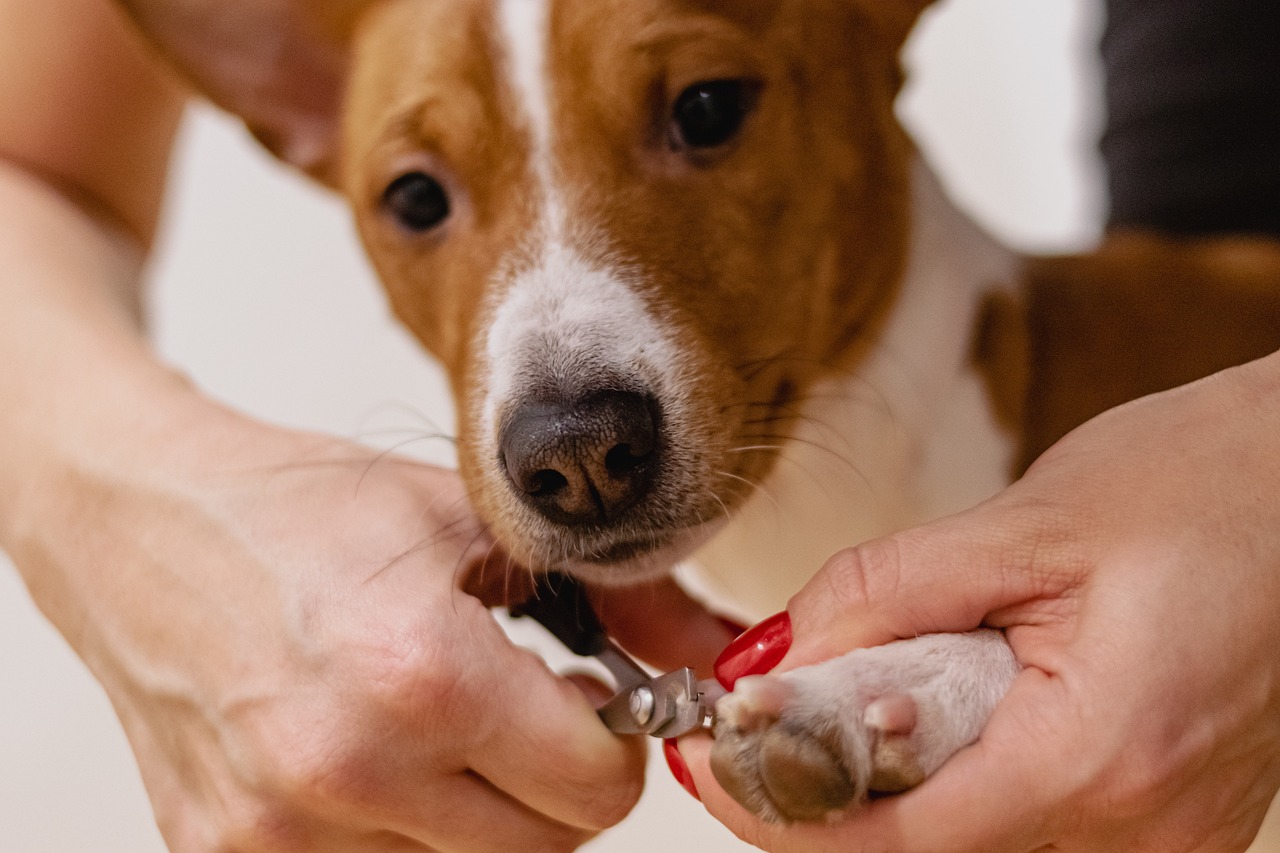
Professional Grooming Services
Sometimes, despite our best efforts, we find ourselves in a situation where are necessary for our long-haired pets. Whether it's due to severe matting, lack of time, or simply the need for a fresh look, knowing when to seek help from a professional can make all the difference in maintaining your pet's coat and overall health. But what exactly can you expect from a grooming session?
When you take your furry friend to a professional groomer, you're not just getting a haircut; you're investing in their comfort and well-being. A skilled groomer will assess your pet's coat condition, check for any underlying skin issues, and provide a range of services tailored to your pet's specific needs. These services often include washing, drying, brushing, and cutting, but may also extend to nail trimming, ear cleaning, and even teeth brushing. After all, grooming is not just about aesthetics; it’s about promoting a healthy lifestyle for your pet.
Before booking an appointment, it's important to consider a few factors:
- Experience and Specialization: Not all groomers are created equal. Look for someone who specializes in long-haired breeds and has a good reputation.
- Facility Standards: Visit the grooming facility beforehand to ensure it is clean, organized, and equipped with the right tools.
- Pet Comfort: A good groomer will prioritize your pet's comfort and will handle them gently to reduce stress.
In addition to finding the right groomer, understanding the costs involved in professional grooming can help you budget accordingly. Grooming prices can vary based on several factors, including:
| Service | Average Cost |
|---|---|
| Basic Grooming (Bath & Brush) | $30 - $60 |
| Full Grooming (Includes Haircut) | $50 - $100 |
| Nail Trimming | $10 - $20 |
| Ear Cleaning | $10 - $15 |
Keep in mind that while grooming may seem like an added expense, it is a crucial part of your pet’s health regimen. Regular visits can help catch potential skin problems early, and they’ll leave your pet looking and feeling fabulous. So, when in doubt, don’t hesitate to reach out to a professional. Your long-haired companion will thank you with wagging tails and happy purrs!
1. How often should I take my long-haired pet to a groomer?
It depends on the breed and coat type, but generally, every 4 to 8 weeks is recommended to keep their coat healthy and mat-free.
2. Can I groom my pet at home instead of going to a professional?
Absolutely! Regular brushing at home can help prevent matting. However, for severe cases, professional help may be necessary.
3. What should I look for in a groomer?
Look for experience with long-haired breeds, positive reviews, a clean facility, and a gentle approach to handling pets.
4. How much should I expect to pay for grooming?
Costs vary widely based on services provided and your location. Basic grooming can range from $30 to $100 or more depending on the specific needs of your pet.
Finding a Qualified Groomer
When it comes to maintaining your long-haired pet's coat, finding a qualified groomer can make all the difference. Not all groomers are created equal, and the right one can help ensure your furry friend remains comfortable, healthy, and looking fabulous. So, how do you find a groomer who truly understands the specific needs of long-haired pets? First, consider seeking recommendations from fellow pet owners or your veterinarian. They often have insights into local groomers who specialize in long-haired breeds.
Once you have a few names, it's essential to do a little research. Check online reviews and testimonials to gauge the experiences of other pet owners. Look for comments about the groomer's patience, skill level, and ability to handle matted fur. A groomer who has a strong reputation in the community is likely to provide the quality care your pet deserves.
Another important factor to consider is the groomer's experience with specific breeds. Some groomers may specialize in certain types of dogs or cats, while others may have a more general approach. It's worth asking about their experience with your pet's breed and coat type, as this can greatly influence the grooming process. For instance, a groomer familiar with the intricacies of a Persian cat's coat will have a different approach than one who primarily works with short-haired breeds.
Don't hesitate to schedule a consultation or a trial grooming session. This allows you to observe how the groomer interacts with your pet. Is the groomer gentle and attentive? Do they take the time to explain their grooming process? Such interactions can provide valuable insight into whether they are the right fit for your pet.
Lastly, consider the grooming facility's environment. A clean, well-organized space is crucial for ensuring your pet's safety and comfort. Check for proper sanitation practices and the presence of necessary equipment. If the facility feels chaotic or unkempt, it might be a sign to look elsewhere.
In summary, finding a qualified groomer involves a combination of research, recommendations, and personal observations. By being thorough in your search, you can ensure that your long-haired pet receives the best possible grooming care, keeping them comfortable and their coat looking stunning.
- How often should I take my long-haired pet to the groomer? It depends on the breed and coat type, but generally, every 4-6 weeks is recommended.
- What should I expect during a grooming session? A typical grooming session may include brushing, bathing, trimming, and nail clipping, tailored to your pet's needs.
- Can I groom my pet at home? Yes, regular at-home grooming can help maintain your pet's coat between professional sessions.
- What if my pet has severe matting? In cases of severe matting, it's best to consult a professional groomer or veterinarian for safe removal.
Understanding Grooming Costs
When it comes to keeping your long-haired pet looking fabulous, understanding grooming costs is essential. Just like humans, our furry friends need regular maintenance to keep their coats healthy and free from mats. However, the costs can vary significantly based on several factors. For instance, the type of grooming service required, the size of your pet, and even your geographical location can all influence the price.
On average, a basic grooming session can range from $30 to $90. This typically includes a bath, brushing, nail trimming, and ear cleaning. However, if your pet requires more specialized services, such as dematting or a specific haircut, you might be looking at higher costs. For example, dematting can add an additional $20 to $50 to your bill, depending on the severity of the mats and the time it takes to address them.
To give you a clearer picture, here’s a breakdown of typical grooming costs:
| Service | Average Cost |
|---|---|
| Basic Grooming | $30 - $90 |
| Dematting | $20 - $50 |
| Specialized Haircuts | $50 - $100 |
| Nail Trimming | $10 - $20 |
| Ear Cleaning | $10 - $15 |
It’s also worth noting that some grooming salons offer package deals, which can save you money in the long run. For instance, you might find a package that includes grooming services for a set monthly fee. This can be a great option if you have a pet that requires regular grooming.
Additionally, don’t forget to factor in the costs of grooming tools and products if you decide to groom your pet at home. Investing in a good quality brush, shampoo, and other grooming supplies can add up, but it can also be a worthwhile investment if you plan to maintain your pet's coat regularly.
Ultimately, understanding grooming costs is about finding a balance between your pet's needs and your budget. Regular grooming is not just a luxury; it’s a necessary part of your pet's health and well-being. By keeping an eye on these costs and planning accordingly, you can ensure that your long-haired companion stays comfortable and stylish.
- How often should I groom my long-haired pet? - It depends on the breed, but generally, every 4 to 6 weeks is a good starting point.
- Can I groom my pet at home? - Yes, many pet owners successfully groom their pets at home with the right tools and techniques.
- What should I do if I find mats in my pet's fur? - Address mats as soon as possible using appropriate grooming tools, or seek professional help if they are severe.

Health Implications of Matting
Matting is not just an aesthetic issue for long-haired pets; it can lead to serious health implications that every pet owner should be aware of. When fur becomes tangled and knotted, it can create a host of problems that go beyond mere discomfort. For instance, mats can trap moisture and debris against the skin, creating an environment ripe for skin infections. Imagine wearing a wet sweater all day; it would be uncomfortable, right? Well, that’s exactly what your pet feels when they have matted fur.
Furthermore, mats can pull on the skin, leading to irritation and pain. This discomfort can make your pet more irritable and less active, affecting their overall quality of life. In severe cases, mats can even restrict blood flow, leading to more serious health concerns. Therefore, it’s crucial to understand the potential health risks associated with neglecting matting.
Here are some common health issues that can arise from matting:
- Skin Infections: Mats can trap moisture and bacteria, leading to infections that may require veterinary intervention.
- Hot Spots: These are localized areas of inflammation and infection that can develop under mats, causing severe itching and discomfort.
- Fleas and Parasites: Mats can provide a cozy hiding spot for fleas and other parasites, making it easier for infestations to occur.
- Skin Irritation: The constant pulling of matted fur can lead to redness, inflammation, and even open sores.
Recognizing the signs of these issues early can make a significant difference in your pet's health. Look out for symptoms such as excessive scratching, biting at the fur, or changes in behavior. If you notice any of these signs, it’s essential to consult a veterinarian promptly.
In addition to addressing the immediate concerns of matting, maintaining your pet's overall health is vital for preventing future issues. A balanced diet, regular exercise, and adequate hydration all contribute to a healthy coat. Moreover, regular veterinary check-ups can help identify any underlying health issues that may contribute to matting. Think of it as a team effort: you and your vet working together to keep your furry friend happy and healthy.
In summary, while matting may seem like a minor inconvenience, the health implications can be quite serious. By staying vigilant and proactive, you can ensure that your long-haired pet remains comfortable and healthy.
Q: How often should I groom my long-haired pet?
A: It depends on the breed and coat type, but generally, long-haired pets should be groomed at least once a week to prevent matting.
Q: What should I do if I find a mat in my pet's fur?
A: Carefully try to loosen the mat with your fingers or a comb. If it’s too tight, consider seeking help from a professional groomer.
Q: Can matting lead to serious health issues?
A: Yes, matting can lead to skin infections, irritation, and even restrict blood flow, which can affect your pet's overall health.
Q: What are the signs of skin problems related to matting?
A: Look for excessive scratching, biting at the fur, redness, or any unusual behavior that indicates discomfort.
Q: Should I take my pet to a vet for matting issues?
A: If you notice signs of skin problems or if the matting is severe, it’s best to consult a veterinarian.
Signs of Skin Problems
As a loving pet owner, it's crucial to be vigilant about your long-haired furry friend’s health, especially when it comes to their skin. Skin problems can arise due to matting, and recognizing the signs early can make a significant difference in your pet's comfort and overall well-being. So, what should you be looking for? Let’s dive into some common indicators that might suggest your pet is experiencing skin issues.
First and foremost, excessive scratching or biting at the skin is a major red flag. If you notice your pet constantly nibbling at their fur or scratching themselves, it could indicate irritation or discomfort caused by mats pulling on their skin. Additionally, look out for redness or inflammation in the areas where mats are present. This can signal that the skin is not only irritated but might also be infected.
Another sign to watch for is the presence of unusual odors. If your pet's coat has a foul smell, it could be a sign of a skin infection or the buildup of bacteria due to trapped moisture under the mats. Furthermore, hair loss in patches or overall thinning of the coat can indicate that mats are causing stress to the hair follicles, leading to shedding. You might also observe scabs or sores forming, which can be painful and require immediate attention.
Sometimes, mats can create a perfect environment for parasites like fleas or ticks. If you notice your pet scratching more than usual or see tiny black specks in their fur (which could be flea dirt), it’s time for a closer inspection. It’s essential to address these issues promptly to prevent further complications. If any of these symptoms persist, consulting a veterinarian is highly recommended.
To summarize, here are some key signs of skin problems to keep an eye on:
- Excessive scratching or biting
- Redness or inflammation
- Unusual odors
- Hair loss or thinning coat
- Scabs or sores
- Presence of fleas or ticks
By being proactive and observant, you can help ensure that your long-haired pet remains healthy and free from the discomfort caused by matting and related skin issues. Regular grooming and check-ups can go a long way in preventing these problems from arising in the first place.
Here are some common questions pet owners have regarding signs of skin problems in their long-haired pets:
- What should I do if I notice mats in my pet's fur? It's best to gently try to remove the mats using appropriate grooming tools. If they are too tight or causing discomfort, consult a professional groomer or veterinarian.
- How can I prevent skin problems related to matting? Regular grooming, a healthy diet, and routine veterinary check-ups can help keep your pet's skin and coat in optimal condition.
- When should I take my pet to the vet? If you notice persistent signs of skin problems, such as sores, excessive itching, or unusual odors, it’s time to consult your veterinarian for a proper assessment.
Preventive Health Care
When it comes to maintaining your long-haired pet's beautiful coat, preventive health care is just as important as regular grooming. Think of it like a solid foundation for a house; without it, everything else becomes shaky. A well-balanced diet, adequate hydration, and regular veterinary check-ups can significantly reduce the chances of matting and other coat-related issues.
First and foremost, diet plays a crucial role in the health of your pet's coat. Just like humans, pets require a balanced diet rich in essential nutrients to keep their skin and fur healthy. Look for high-quality pet foods that contain omega-3 and omega-6 fatty acids, which are known to promote a shiny coat and reduce shedding. Here’s a quick breakdown of some beneficial food components:
| Nutrient | Benefits |
|---|---|
| Omega-3 Fatty Acids | Promotes skin health and reduces inflammation |
| Omega-6 Fatty Acids | Helps maintain a healthy coat and skin barrier |
| Vitamins A and E | Supports skin repair and overall coat health |
Next, let’s talk about hydration. Just as a plant needs water to thrive, your pet's skin and coat require proper hydration to stay healthy. Ensure your pet has access to fresh, clean water at all times. Dehydration can lead to dry skin, which in turn can cause matting and discomfort. If you're unsure if your pet is drinking enough, you can check their skin elasticity; gently pinch the skin on the back of their neck, and if it doesn’t spring back quickly, they may be dehydrated.
Another vital aspect of preventive health care is scheduling regular veterinary check-ups. These visits allow your vet to assess your pet's overall health and catch any potential issues before they escalate. During these check-ups, your vet can provide tailored advice on grooming and nutrition based on your pet's specific needs. Don't hesitate to ask questions about your pet's coat health; after all, you want to ensure your furry friend is as comfortable and happy as possible!
In addition to diet, hydration, and vet visits, consider incorporating some at-home care practices into your routine. For example, regular baths using pet-friendly shampoos can help remove dirt and debris that contribute to matting. Furthermore, brushing your pet's coat regularly not only helps prevent tangles but also distributes natural oils, keeping their skin moisturized and healthy. Aim for at least once a week for maintenance, but daily brushing may be necessary for particularly long or thick coats.
In conclusion, preventive health care is essential for keeping your long-haired pet's coat looking its best and minimizing the risk of matting. By focusing on a balanced diet, ensuring proper hydration, scheduling regular vet check-ups, and incorporating at-home grooming practices, you can help your furry friend maintain a healthy and beautiful coat for years to come. Remember, a little effort goes a long way in ensuring your pet’s comfort and well-being!
- How often should I groom my long-haired pet? It depends on the breed and coat type, but generally, daily to weekly grooming is recommended to prevent matting.
- What are the signs of matting? Look for visible tangles or knots in the fur, as well as signs of discomfort, such as scratching or licking.
- Can matting cause health issues? Yes, matting can lead to skin infections, discomfort, and even pain if not addressed promptly.
- Should I bathe my pet regularly? Bathing should be done as needed, generally every 4-6 weeks, depending on your pet's lifestyle and coat condition.
- When should I seek professional grooming services? If mats are severe or if grooming becomes too challenging, it's wise to consult a professional groomer.
Frequently Asked Questions
- What causes matting in long-haired pets?
Matting in long-haired pets can occur due to a variety of factors, including lack of regular grooming, dirt, debris, and even moisture. When fur becomes tangled, it can create knots that tighten over time, leading to discomfort for your furry friend. Additionally, certain breeds are more prone to matting due to their coat type.
- How often should I groom my long-haired pet?
The frequency of grooming depends on your pet's coat type and lifestyle. Generally, long-haired pets should be groomed at least once a week, but some may require daily grooming to prevent mats. Establishing a regular grooming schedule helps maintain their coat and reduces the risk of matting.
- What tools are best for grooming long-haired pets?
Choosing the right grooming tools is essential for effective care. Slicker brushes, pin brushes, and wide-toothed combs are commonly recommended for long-haired pets. Each tool serves a specific purpose, so it's important to understand your pet's coat type to select the best tools for their grooming needs.
- How can I safely remove mats from my pet's fur?
To safely remove mats, start by using a wide-toothed comb to gently detangle the fur. Work from the ends of the hair towards the skin, being careful not to pull too hard. For stubborn mats, you may need to use a slicker brush or, in severe cases, consult a professional groomer to avoid hurting your pet.
- When should I consider professional grooming services?
If you find that mats are too difficult to remove or if your pet is uncomfortable during grooming, it may be time to seek professional help. Groomers have the expertise and tools necessary to manage severe matting and can provide a thorough grooming session to keep your pet's coat healthy.
- What are the health risks associated with matting?
Matting can lead to several health issues, including skin infections, irritation, and discomfort. Mats can trap moisture and dirt against the skin, creating an environment where bacteria thrive. Regular grooming and maintenance are crucial to prevent these health risks for your long-haired pet.
- How can I tell if my pet has skin problems related to matting?
Signs of skin problems may include redness, swelling, itching, or unusual odor. If you notice your pet scratching excessively or if there are visible irritations, it's essential to consult a veterinarian for a proper diagnosis and treatment plan. Early intervention can prevent more serious issues.
- What preventive care can I provide to help my pet's coat stay healthy?
Maintaining a healthy diet, ensuring proper hydration, and scheduling regular veterinary check-ups are vital for your pet's overall health and coat condition. A balanced diet rich in essential nutrients can enhance coat quality and reduce the likelihood of matting.

